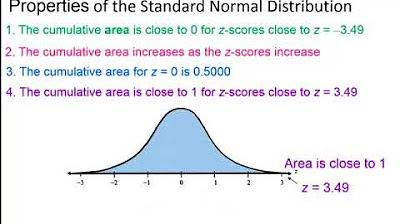What is Skewness? | Statistics | Don't Memorise
TLDRThe script explores the concept of data distribution, contrasting normal distribution with skewed distributions. It explains that while student heights follow a symmetrical bell curve, income distribution often shows a positive skew with a long tail on the higher income side. Conversely, an easy test's scores may demonstrate a negative skew, with a tail on the lower marks side. The summary highlights the importance of recognizing skewness in data analysis.
Takeaways
- 📏 The script discusses the concept of normal distribution and its characteristics, such as equal distribution of data on both sides of the central value, which is also the maximum point.
- 📉 It introduces the idea of a bell curve, which is the graphical representation of a normal distribution, resembling the shape of a bell.
- 🤔 The script questions whether all data is normally distributed and symmetrical, setting the stage for exploring different types of data distributions.
- 📊 An example of income distribution is used to illustrate a positively skewed distribution, where the tail extends towards the higher values, indicating more people earning less than the central value.
- 💼 The central value in the income distribution example is around '50,000 dollars, highlighting the point where the data distribution is most concentrated.
- 🔍 The script zooms in to show that the majority of people earn between '20,000' and '50,000' dollars, with fewer individuals earning outside this range.
- 📈 The concept of skewness is introduced, explaining that it is the lack of symmetry in a distribution, with the data not being equally distributed on both sides of the central value.
- 📉 The script contrasts the positively skewed income distribution with a normal distribution, showing the difference in their shapes.
- 📚 Another example is given using student test scores to demonstrate a negatively skewed distribution, where the tail is on the left-hand side of the central value.
- 🏆 In the test scores example, the majority of students scored between '50 and 80', with the central value being '50', indicating that more students scored below this value.
- 🔄 The script concludes by summarizing the three types of distributions: normal, positively skewed, and negatively skewed, emphasizing the direction of the tail in relation to the central value.
Q & A
What is the significance of the line denoting students' heights in the script?
-The line represents a visual tool to plot and analyze the distribution of students' heights, which is a key aspect of understanding data distribution patterns.
Why were the heights recorded in intervals of '0.2' meters?
-Recording heights in intervals of '0.2' meters allows for a more detailed and structured analysis of the data, making it easier to identify patterns and trends.
What is the central value in the normal distribution of students' heights?
-The central value in the normal distribution of students' heights is '1.5' meters, which is the point where the maximum number of students is recorded.
Why is the normal distribution also called a bell curve?
-The normal distribution is referred to as a bell curve because its shape resembles the outline of a bell, with the central value at the peak and the data points tapering off symmetrically on both sides.
What does it mean when data is not normally distributed?
-When data is not normally distributed, it means that the data points do not follow a symmetrical bell curve pattern, often indicating irregularities or specific characteristics in the data set.
How does the income distribution in the given region differ from a normal distribution?
-The income distribution in the region differs from a normal distribution because it has a long tail on the right-hand side, indicating a positively skewed distribution with more high-income earners than expected in a normal distribution.
What is the central value of the income distribution in the region?
-The central value of the income distribution in the region is around '50,000 dollars, which is the income level at which the majority of people earn.
What is skewness in the context of data distribution?
-Skewness refers to the asymmetry in the distribution of data points around the central value, indicating that one side of the distribution has more spread or heavier tails than the other.
How does positive skewness differ from negative skewness?
-Positive skewness occurs when the tail of the distribution is on the right side of the central value, indicating more data points at higher values. Negative skewness occurs when the tail is on the left side, indicating more data points at lower values.
What does the distribution of marks scored by students in an easy test indicate about the test difficulty?
-The distribution of marks in an easy test, with a majority of students scoring between '50 and 80' and a central value of '50', suggests that the test was not challenging enough to differentiate between high and low performers effectively.
How can the concept of skewness be used to analyze real-world data?
-Skewness can be used to analyze real-world data by identifying trends and irregularities, such as income inequality or the performance distribution in a test, which can inform further research or policy decisions.
Outlines
📊 Understanding Normal Distribution
This paragraph introduces the concept of normal distribution, also known as the bell curve, by analyzing the heights of a large group of students measured in meters. The data is noted to be symmetrically distributed around the central value of 1.5 meters, with equal intervals of 0.2 meters marking the height categories. The maximum number of students is found at this central height, illustrating the typical characteristics of a normal distribution where data points are evenly spread on either side of the mean.
💰 Exploring Skewed Income Distribution
The second paragraph delves into the concept of skewed distribution by examining annual income data in a specific region. The income range is from 10,000 to 100,000 dollars, with the majority of individuals earning between 20,000 and 50,000 dollars. The central value is identified as 50,000 dollars, but the data reveals a significant 'tail' on the right side, indicating a positive skewness. This means that while most people earn around the central value, a smaller proportion earns significantly more, creating an asymmetrical distribution compared to the normal distribution curve.
📚 Negative Skewness in Student Test Scores
The final paragraph contrasts positive skewness with negative skewness using the example of student test scores on an easy exam. The scores range from 20 to 80, with the majority of students scoring between 50 and 80, and the central value being 50. A 'tail' is observed on the left side of the central value, indicating that fewer students scored below the central value, thus the distribution is negatively skewed. This paragraph emphasizes the difference between normal distribution and skewed distributions, highlighting the direction of the tail as a key indicator of the skewness type.
Mindmap
Keywords
💡Normal Distribution
💡Bell Curve
💡Skewness
💡Positive Skewness
💡Negative Skewness
💡Central Value
💡Data Distribution
💡Interval
💡Symmetry
💡Income Distribution
💡Test Scores
Highlights
The concept of normal distribution is introduced, characterized by equal distribution of data on both sides of the central value, resembling a bell curve.
Normal distribution is illustrated with the example of students' heights, with the maximum frequency at 1.5 meters.
Income distribution is used as an example to demonstrate a positively skewed distribution, with a long tail on the right side of the central value.
A majority of people earn between 20,000 and 50,000 dollars annually, indicating a central value around 50,000 dollars.
The difference between normal distribution and positively skewed distribution is highlighted through a comparison.
Negative skewness is explained using the example of students' marks in an easy test.
In the test scores example, the majority of students scored between 50 and 80, with the central value at 50.
A tail on the left-hand side of the central value indicates a negatively skewed distribution.
The transcript provides a clear distinction between positively skewed, negatively skewed, and normal distributions.
Skewness is defined as the lack of equal distribution on both sides of the central value in a dataset.
The transcript explains how to identify the direction of skewness by observing the tail of the distribution.
A visual representation of the three types of distributions is provided to aid understanding.
The importance of recognizing skewness in data analysis is emphasized for accurate interpretation.
The transcript uses real-world examples to make the concept of skewness more relatable and understandable.
The impact of skewness on statistical analysis and decision-making is implicitly discussed.
The transcript concludes by reinforcing the significance of understanding distribution types in data representation.
Transcripts
Browse More Related Video

Statistics-Left Skewed And Right Skewed Distribution And Relation With Mean, Median And Mode

Log normal distribution | Math, Statistics for data science, machine learning

What is a Bell Curve or Normal Curve Explained?

Skewness - Right, Left & Symmetric Distribution - Mean, Median, & Mode With Boxplots - Statistics

Elementary Statistics - Chapter 6 Normal Probability Distributions Part 1

The Normal Distribution, Clearly Explained!!!
5.0 / 5 (0 votes)
Thanks for rating: